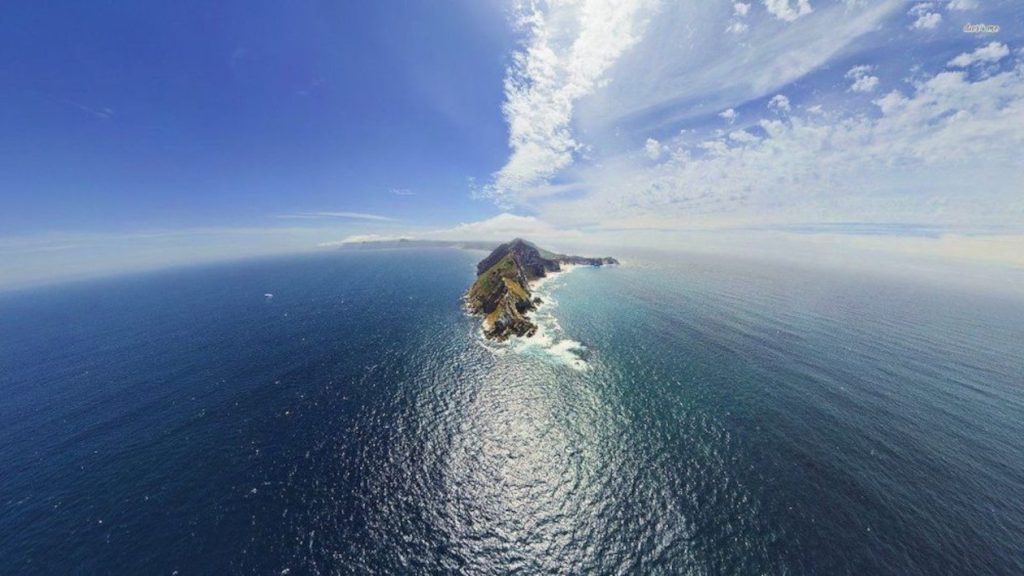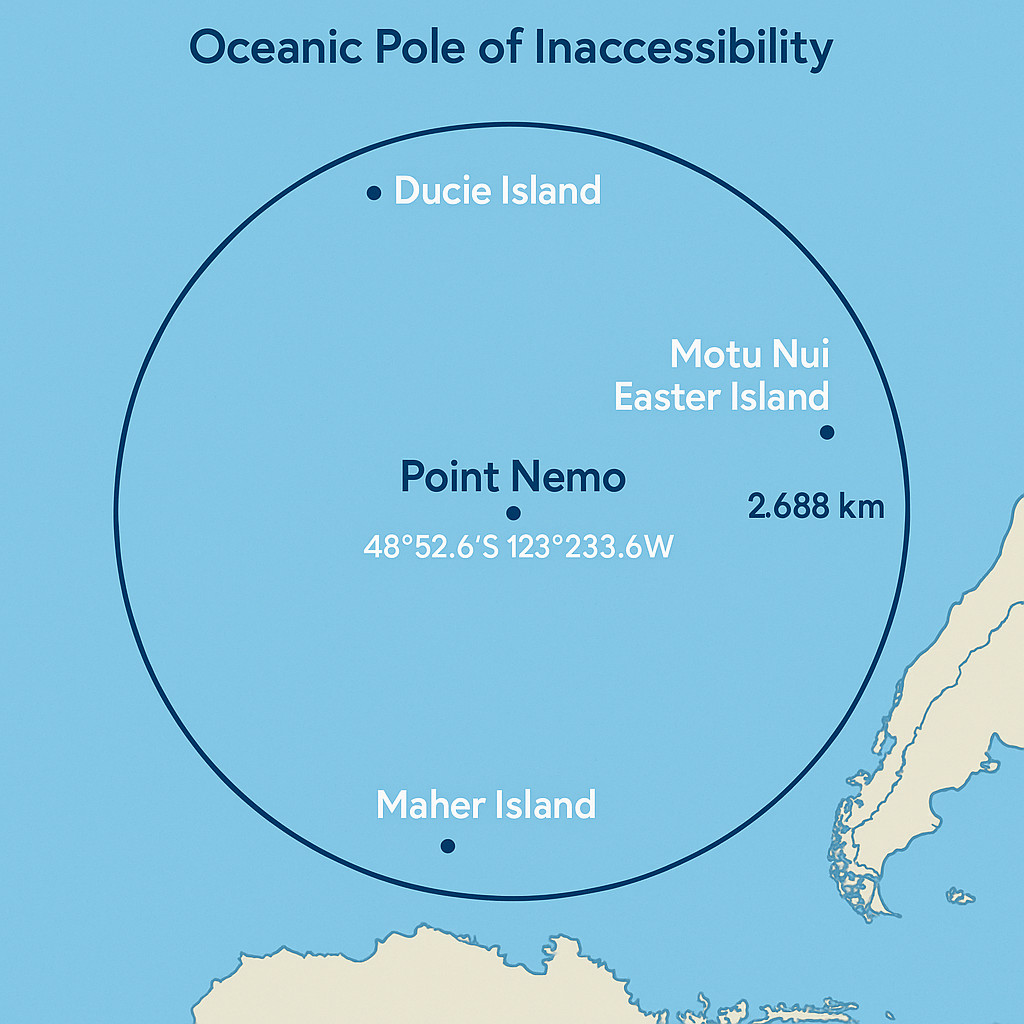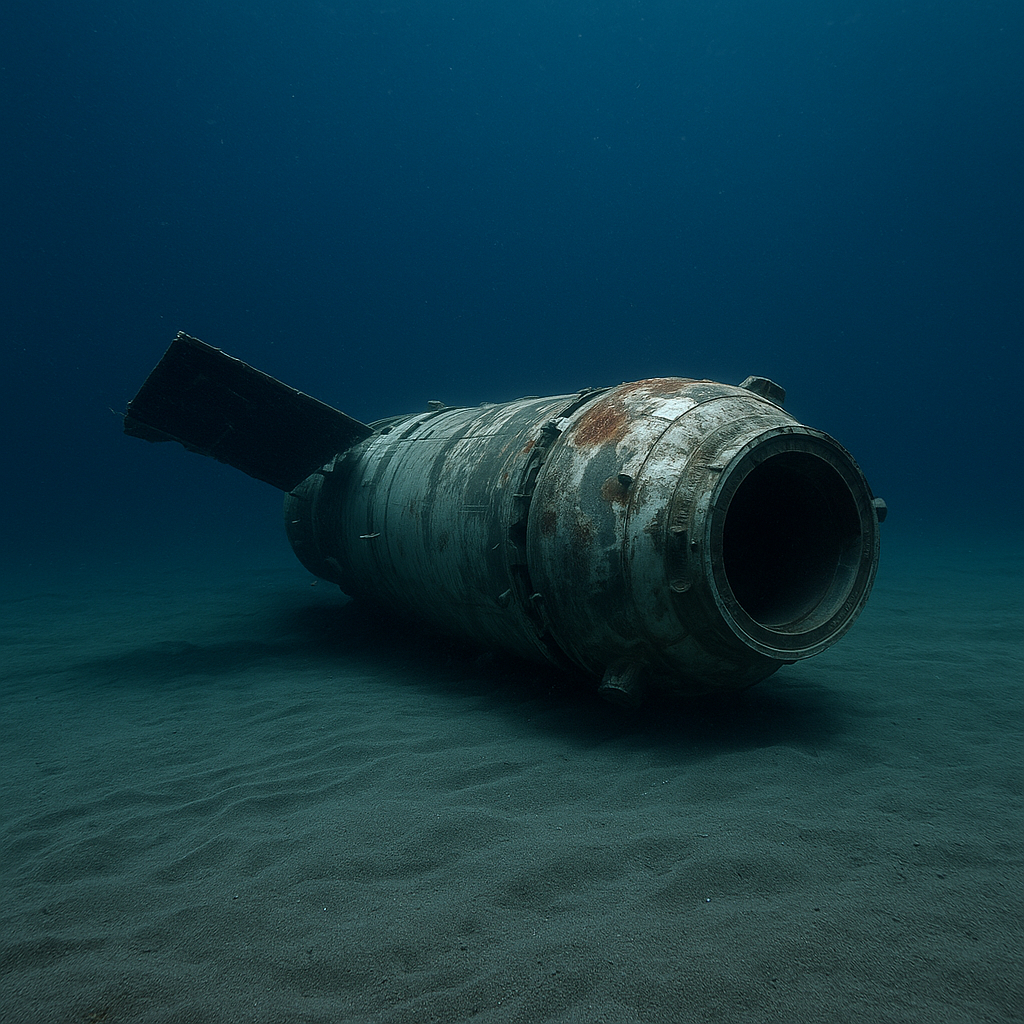In the middle of the vast South Pacific Ocean lies a place so remote that few people have ever heard of it: Point Nemo. Known as the oceanic pole of inaccessibility, it is the spot in the ocean farthest from any land. Reaching it would mean traveling more than 2,600 kilometers in any direction before touching solid ground.

What makes Point Nemo remarkable is not only its extreme isolation, but also its unique role in science and exploration. It marks the center of a marine desert with little life, it is often closer to astronauts orbiting Earth than to any human on land, and it has become the final resting place for decommissioned spacecraft.
Far from being a sensational mystery, Point Nemo offers a real glimpse into the limits of our planet and the imagination it continues to inspire.
What is Point Nemo?

Point Nemo, officially known as the oceanic pole of inaccessibility, is the point in the world’s oceans that lies farthest from any land. Its exact coordinates are 48°52.6′S 123°23.6′W, in the South Pacific Ocean. The closest landmasses are more than 2,600 kilometers (1,450 nautical miles) away:
- Ducie Island (part of the Pitcairn Islands) to the north,
- Motu Nui (near Easter Island) to the northeast,
- Maher Island (near Antarctica) to the south.
Because of this extreme distance, Point Nemo is often described as the “center of the ocean.” The vast stretch of water around it covers an area larger than many countries combined, making it one of the most isolated places on Earth.
For most of human history, Point Nemo was unknown—not because it is physically inaccessible, but because it could only be identified through modern geographic calculations.
Discovery of Point Nemo
The location of Point Nemo was not discovered by sailors or explorers at sea, but by mathematics and computer modeling. In 1992, Croatian-Canadian survey engineer Hrvoje Lukatela calculated its location using a geospatial computer program called Hipparchus. By identifying the point in the Pacific Ocean farthest from any coast, he revealed what is now considered the most isolated spot on Earth.
The discovery highlighted how modern technology allows us to understand our planet in ways that were impossible before. Unlike traditional geographical landmarks, Point Nemo is invisible—there is no island, no marker, and no structure to identify it. Its existence is purely defined by distance and coordinates.
This unique nature makes Point Nemo not a destination in the conventional sense, but a concept that challenges how we think about geography, exploration, and the limits of human presence on Earth.
Geography and Environment
Located in the South Pacific Ocean, This place sits in the middle of one of the most isolated regions on the planet.
The surrounding waters are part of the South Pacific Gyre, a massive system of rotating currents that keeps nutrient-rich waters from reaching this area. As a result, Point Nemo is considered a marine desert.
Unlike coastal waters or tropical reefs, the ocean here supports very little life. Few fish, plankton, or marine mammals can survive in such nutrient-poor conditions.
This lack of biodiversity makes Point Nemo unique: while it is vast in scale, it is strikingly empty compared to most other ocean regions.
Geographically, Point Nemo is not marked by any island or visible feature—it exists only as a set of coordinates. Its significance comes not from what is found there, but from what is absent: people, ecosystems, and even ships, since few vessels have reason to pass through such an empty part of the ocean.
The Spacecraft Cementery

One of the most unexpected roles of this “magical place” is that it serves as the world’s “spacecraft cemetery.” Because the area is so remote and virtually uninhabited, international space agencies use it as a controlled crash site for decommissioned satellites and space stations. By directing spacecraft to re-enter Earth’s atmosphere above this region, the risk of debris falling near populated areas is minimized.
More than 250 space objects have been laid to rest here, including cargo ships, satellites, and the Russian space station Mir, which was brought down in 2001. In the coming years, Point Nemo will again make headlines as the planned final destination of the International Space Station (ISS) when it is retired, expected around 2031.
This hidden underwater graveyard connects one of the most remote places on Earth with some of humanity’s most advanced technological achievements, highlighting the unusual ways in which science and geography intersect.
The Closest Humans Are in Space
Perhaps the most striking fact about Point Nemo is that the nearest humans are often not on Earth at all. Astronauts aboard the International Space Station (ISS), orbiting about 400 kilometers above the planet, are frequently closer to Point Nemo than any person on land.
This extraordinary detail underscores just how isolated the location is. Unlike other remote points on the globe—such as deserts or polar regions—Point Nemo’s remoteness is not just about distance, but about the sheer absence of human presence. No permanent settlements exist within thousands of kilometers, and even ships rarely pass nearby.
In many ways, this reality captures the essence of this place: it is not only geographically extreme, but also symbolically a reminder of how vast and uninhabited much of our planet still remains.
Cultural References and Curiosities

Point Nemo has not only drawn the attention of scientists and space agencies—it has also inspired writers, artists, and the public imagination.
One of the most famous references comes from H.P. Lovecraft, who in 1928 described the underwater city of R’lyeh in his short story The Call of Cthulhu. Remarkably, the fictional coordinates Lovecraft gave for R’lyeh are located not far from what would later be calculated as Point Nemo, decades before its official discovery. This coincidence has fueled speculation and popular myths, even though the connection is purely fictional.
Another curiosity is the mysterious sound known as “The Bloop.” Recorded by underwater microphones in 1997, it was one of the loudest unexplained ocean noises ever captured, and it originated near Point Nemo. While early speculation linked it to sea monsters, scientists later determined it was most likely the sound of icequakes—massive icebergs cracking and shifting in the Southern Ocean.
These cultural associations add layers of mystery and intrigue, but they also highlight something deeper: Point Nemo fascinates us not because of what it contains, but because of the imagination it inspires in the face of such emptiness.
How Deep Is the Ocean at Point Nemo?
Although Point Nemo is famous for its remoteness, another frequent question is how deep the ocean is at this location. The seabed beneath Point Nemo lies at an average depth of about 4,000 meters (13,000 feet), placing it within the abyssal zone of the Pacific Ocean.
This immense depth is typical of the open ocean but far shallower than Earth’s deepest point, the Mariana Trench, which plunges more than 11,000 meters. Still, the waters beneath Point Nemo are dark, cold, and under extreme pressure—conditions that make human exploration impossible without specialized submersibles.
Has Anyone Reached Point Nemo?
For many years, Point Nemo was thought of as a place that existed only on maps and in theory. Its extreme isolation made it unlikely that anyone would ever attempt to visit it.
However, in March 2024, British explorer Chris Brown and his son Mika successfully reached Point Nemo. Their expedition began on March 12 in Puerto Montt, Chile, aboard the research and expedition yacht Hanse Explorer. After traveling across the South Pacific, they arrived at the exact coordinates of Point Nemo on March 20.
This achievement marked one of the very few documented visits to the oceanic pole of inaccessibility. While there is nothing to see at the site except endless ocean, their journey proved that even the most remote points on Earth can be reached through determination, advanced navigation, and modern vessels.
Today, their expedition stands as a reminder that Point Nemo is not just a theoretical point on a map—it is a real place, one that pushes the limits of human exploration.
Why Does Point Nemo Matter?
Beyond its mystery and cultural references, Point Nemo has genuine importance for science and our understanding of the planet.
- Oceanography and ecosystems: Studying the South Pacific Gyre, where Point Nemo lies, helps researchers understand how ocean currents circulate nutrients and pollutants. Because the region is so isolated and nutrient-poor, it provides insight into the limits of marine life and how ecosystems function in extreme conditions.
- Space exploration and safety: As the designated site for controlled spacecraft re-entry, Point Nemo plays a critical role in minimizing risks to human populations. The use of this remote area highlights how geography is essential even in planning the future of space travel.
- Environmental questions: While most debris burns up in the atmosphere before reaching the ocean, the growing number of spacecraft directed toward Point Nemo raises questions about the long-term environmental impact on these waters.
- Human imagination: Finally, Point Nemo symbolizes humanity’s ongoing fascination with frontiers—places where isolation, science, and myth intersect. It reminds us how much of the ocean remains unexplored, and how even invisible points on a map can spark wonder and curiosity.
Conclusion
Point Nemo may never be a travel destination, but it remains one of the most fascinating places on our planet. Defined not by what it contains, but by its isolation, it connects oceanography, space exploration, and even literature in a way few other locations can.
Its role as both a marine desert and a spacecraft cemetery highlights how extreme environments help us understand the boundaries of life and technology. At the same time, the stories and cultural references surrounding it remind us of the power of imagination when faced with the unknown.
Point Nemo stands as a symbol of distance and discovery—an invisible landmark in the middle of the ocean that continues to expand our sense of wonder about Earth and beyond.
